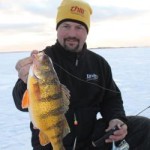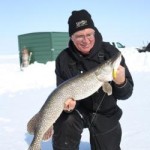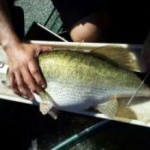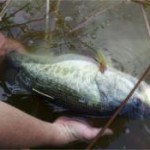Chickamauga Bass with Jeremy York
Chickamauga has been the best bass lake in the Southeast, if not in the whole country, the past few months. Many eight pound plus bass have been landed and in most tournaments you didn’t even need to weigh in if you had five bass weighing less than 25 pounds.
The bad news is the patterns producing those incredible stringers working the first three months in 2013 year are over by the end of March. The good news is those bass are still there, hungry in May and can be caught on a variety of new patterns.
Chickamauga is a TVA Lake just outside Chattanooga on the Tennessee River. It runs 59 miles from the dam up to the Watts Barr Dam, with many big feeder creeks. Although it is not in Georgia or Alabama, many fishermen in our state are less than three hours away and make the trip often. If you are not one of them you are missing out on some incredible bass fishing.
Jeremy York owns Angler’s Warehouse near Athens, Georgia. Two years ago one of his pro staff invited him to sample the great bass fishing that was just being discovered on Chickamauga. He went up and caught some big bass and fell in love with the lake. He now makes the three hour drive several times a week in the winter and does some guiding on the lake, about 25 trips so far this year.
Jeremy is a tournament fisherman and fishes the pro trails as well as local and regional tournaments. In the BFL on Chickamauga in March, 2013 he weighed in five bass weighing 30.25 pounds – and came in third! In another tournament he had five weighing 27 pounds and came in 14 place.
In five guide trips in March 2013 he and his clients had their five best weighing 26, 39, 36, 30 and 32 pounds. That is better than a six pound average for four of the five trips.
In five trips this year he and his clients have landed an eight pound plus fish in each. One of his best trips was with a father and son. Within a few minutes of starting the father landed an 8.75 pound largemouth, he landed a 6.5 pounder and then the son landed an 8.68 pound fish, all within the first hour.
Jeremy found a pattern that works great from the beginning of January through March. When the water temperature hits 48 degrees the bass really turn on and 48 to 52 is the ideal water temperature. It starts slowly as soon as the water reaches 45 degrees. The pattern holds until the water gets to about 58 degrees, usually around the first of April, and the bass head toward the bedding areas.
Although this pattern is over this year, it is worth remembering for next year. Jeremy came up with the idea for the Extreme Bait Ball Rig that is sold by Picasso. It is an Alabama rig with teasers on the arms, so it looks even more like a school of baitfish. That is what he caught the big bass on from January through March.
He rigs it with one eighth ounce Buckeye Jewell heads on the hook arms and rigs them and the teaser attachments with either a 3.5 or 4.5 inch Shadalicious blue gizzard or Texas shad swimbaits. For bigger bass he runs the 4.5 inch bait on the hooks with smaller ones on the teasers, or runs the bigger size on all.
The ideal rig for throwing this heavy bait is an I Rod Bama Rig Special Genesis II rod with a Revo SX reel spooled with 80 pound Power Pro braid. He tried several reels and all wore out in a few trips except the Revo.
There are three things to remember when throwing this rig. Lob it, don’t make a usual cast. Keep reeling when you feel something until the bass almost jerks the rod out of your hand. You will hit stumps with it and if you set the hook you are unlikely to get the rig back. And finally, when you do hang up, keep your line tight as you go to it, go past the hangup and pop it loose with small pops of the rod tip.
Jeremy took me to Chickamauga the second week of April and warned me the great bite was probably over. Although he got a nice 4.5 pounder first thing that morning on the rig, fishing was slow. We went into the spawning pockets and they were full of bass just starting to fan beds. The fish were very spooky and we could not get them to hit, but we saw many in the six pound plus size starting to bed.
Adding to our problems that day the water rose almost two feet while we were there. The lake is scheduled to be at full pool by April 15th each year and it was four feet low when we got there. But it was filling fast.
When the water temperature is right Jeremy fishes transition areas like stump flats near the mouths of spawning areas. There needs to be deep water nearby with a shelf or flat with stumps on it. A ditch or cut running across the flat is key. The bass feed on those types of places during the winter and pre spawn.
Other good types of cover are banks where big rocks transition to chunk rock to sand, often found at the mouths of feeder creeks and coves. Big largemouth and smallmouth both like this kind of area and will hit the rig fished there. On one trip this year he got a six pound smallmouth and a six pound largemouth.
On the stump flats keep your boat out in deeper water near the cut or ditch and cast up to four or five feet of water. Work your rig back steadily, keeping it above the stumps but near the bottom. On the transition banks stay out a long cast from the bank and cast near it, fishing the rig back to cover water two to six feet deep.
File this information away for next year. But now for the good news. Those big bass are still in the lake and you can catch them right now. Fishing will be good from now through May and you can use a variety of baits to catch them.
Right now (in late April) about half the bass, especially the bigger fish, are on the beds or have been in the last few days. You can sight fish for them or drag a Carolina rigged lizard through the bedding areas. If sight fishing, look for stumps, the favorite place for a bass to bed on Chickamauga.
Jeremy likes a Big Bite Baits Fighting Frog on a light Texas rig, a white swim bait with a weighed keel hook or a whacky rigged Senko rigged weightless for sight fishing. He will cast well past the bed and pull the bait to it, letting it drop into the sweet spot. Let it sit and shake it and the bass will usually eat it if they are hard on the bed.
Good areas for sight fishing are in Soddy Creek, which usually has the clearest water on the lake, and other creeks on the lower half of the lake. The pockets up the river are full of spawning bass, too, but they are harder to see since the water is usually more stained there.
Another good area is Dallas Bay around Chester Frost Park. Jeremy says there have probably been 100 eight pound plus bass released there in tournaments this year and they will not leave the bay since the spawn is approaching. They will stay in the bay, feed until spawning and then gradually work back out to the river, feeding on post spawn areas.
The stump flats on both sides of the ramp are good spawning areas to check since they are littered with stumps. Be careful, the flats run way out. Try to follow the ditches and cuts going back into them since the bass will follow them. Often the biggest bass will be bedding on stumps closest to the deeper water in the cuts.
Bass move into the spawning areas in waves and about half of them are there now the last week of April. More will move in during the next few weeks, depending on water temperature and moon phase. They will stay on the bed for about a week then move off and spend about a week recovering. They won’t feed much during that week but will start feeding heavily after that so there will be a lot of hungry fish all during the month of May.
To catch post spawn fish Jeremy will try a variety of baits. A Spook or similar walking bait worked over the stump flats will draw explosive strikes. Keep your boat in the cuts and cast ahead of you down the cut and fan cast the flats on both sides. Cover a lot of water, fishing fast until you find feeding fish.
A swim jig worked over the same areas will also catch fish, especially if the fish are not real aggressive. Swim it in the same places you worked your topwater. You can also work a spinnebait over those areas or try to bump the stumps with a square bill crankbait.
Toward the end of May there will still be a few bedding bass but the bream spawn comes into play. Bass will feed on the bream that are bedding in the same areas as the bass use, so fish a swim jig around the bedding bream to catch those bass feeding on bream.
Another big key in May is the shad spawn. Chickamauga has two kinds of shad, both threadfin and gizzard shad, and golden shiners, all favorite foods of bass. The shad will spawn on gravel and shell bed flats and rocky banks this month and the bass often go wild feeding on them. Jeremy says the shell beds on flats near the river channel are a huge key to the shad spawn so seek them out.
Look for the schools of shad running the banks early in the morning or working the flats. Jeremy likes to see smaller areas of shad spawning. If there are shad spawning on 100 yards of bank there might be 20 bass feeding on them and they will be real scattered out. If there are shad on only about 20 feet of bank, those same 20 bass will be concentrated and easier to catch.
A spinnerbait, rattle bait or swim jig all work well on the shad spawn. Work them over the flats, running them right on the bottom. On the banks, cast right to the bank, even up on the rocks and pulling your bait into the water. The bass will be facing the bank so you want to cast as shallow as possible.
The shad usually spawn early, the first couple of hours of light on sunny days, but will stay shallow much longer on cloudy days. If it is sunny and the shallow activity stops, back off and fish a little deeper to catch the bass following the shad out a little ways off the bank where they hold until the next morning.
Why is Chickamauga so hot with big bass right now? Jeremy says the stocking of Florida and Northern strain largemouth as produced a cross, an F1 hybrid that grows very fast and is very aggressive. Tennessee DNR reports show they stocked both Florida and Northern strain largemouth as well as F1 hybrids in 2002. Those fish have reached trophy size and their offspring are reaching bragging size every year.
Jeremy thinks the next two years are going to be fantastic, with some huge bass caught in Chickamauga each year. All those eight to ten pound bass will mostly still be around for a couple of years and could be two to three pounds heavier. And all those five and six pounders will also be two to three pounds heavier.
For the future, there are a lot of four and five pound bass coming along, too. There is a 15 inch size limit on largemouth and an 18 inch size limit on smallmouth on Chickamauga and those limits have contributed to the larger fish in the lake. That size restriction also insures a good supply of quality fish for the future. So the fishing should stay really good for the foreseeable future. You definitely want to head to Chickamauga and get in on catching them.
A three day non resident Tennessee fishing license is $16 and can be bought on line before your trip. A ten day license is $25 and an annual license, good until February each year, is $80. You might want an annual license since you are sure to fall in love with fishing Chickamauga.









